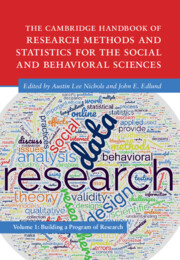 The Cambridge Handbook of Research Methods and Statistics for the Social and Behavioral Sciences
The Cambridge Handbook of Research Methods and Statistics for the Social and Behavioral Sciences Book contents
- The Cambridge Handbook of Research Methods and Statistics for the Social and Behavioral Sciences
- Cambridge Handbooks in Psychology
- The Cambridge Handbook of Research Methods and Statistics for the Social and Behavioral Sciences
- Copyright page
- Dedication
- Contents
- Figures
- Tables
- Contributors
- Preface
- Part I From Idea to Reality: The Basics of Research
- 1 Promises and Pitfalls of Theory
- 2 Research Ethics for the Social and Behavioral Sciences
- 3 Getting Good Ideas and Making the Most of Them
- 4 Literature Review
- 5 Choosing a Research Design
- 6 Building the Study
- 7 Analyzing Data
- 8 Writing the Paper
- Part II The Building Blocks of a Study
- Part III Data Collection
- Part IV Statistical Approaches
- Part V Tips for a Successful Research Career
- Index
- References
5 - Choosing a Research Design
from Part I - From Idea to Reality: The Basics of Research
Published online by Cambridge University Press: 25 May 2023
- The Cambridge Handbook of Research Methods and Statistics for the Social and Behavioral Sciences
- Cambridge Handbooks in Psychology
- The Cambridge Handbook of Research Methods and Statistics for the Social and Behavioral Sciences
- Copyright page
- Dedication
- Contents
- Figures
- Tables
- Contributors
- Preface
- Part I From Idea to Reality: The Basics of Research
- 1 Promises and Pitfalls of Theory
- 2 Research Ethics for the Social and Behavioral Sciences
- 3 Getting Good Ideas and Making the Most of Them
- 4 Literature Review
- 5 Choosing a Research Design
- 6 Building the Study
- 7 Analyzing Data
- 8 Writing the Paper
- Part II The Building Blocks of a Study
- Part III Data Collection
- Part IV Statistical Approaches
- Part V Tips for a Successful Research Career
- Index
- References
Summary
A research design is the sequence of things done in order to collect the information needed to answer a research question. The design states which data will be sought, from which sources, at which times, and in which ways. This chapter describes the influences that shape the decisions researchers must make when constructing a research design. Research designs differ in the source of information used, whether data used are naturally occurring or a result of intervention, and the way data are elicited, recorded, and analyzed. Typically, the nature of the research question, assumptions on which it is based, and ethical considerations drive the design construction. I describe seven major influences on design choice in this chapter: research question novelty; levels of analysis and explanation used; epistemological and ontological assumptions; characteristics of data sources; data analyzability; piloting results; and various practicalities. Understanding these influences will improve research design decisions.
Keywords
- Type
- Chapter
- Information
- The Cambridge Handbook of Research Methods and Statistics for the Social and Behavioral SciencesVolume 1: Building a Program of Research, pp. 85 - 102Publisher: Cambridge University PressPrint publication year: 2023
